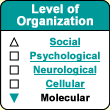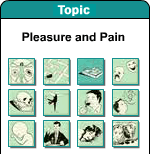| |


A
neuroscientist gets drunk to explain alcohol’s effects on the
brain
Nearly 15% of all men and 30% of all women admit
to a craving for chocolate.
Over 300 substances have
been identified in chocolate. Some of these, including caffeine and theobromine
(another, less powerful stimulant) could actually cause dependency effects. But
the amounts of these substances in chocolate are too small to really have any
effect.
The same goes for phenylethylamine, a substance related to a
family of stimulants called amphetamines. For example, chocolate contains less
phenylethylamine than goat cheese.
Anandamide, a neurotransmitter produced
naturally by the brain, has also been isolated in chocolate. The neural receptors
for anandamide are the same ones to which THC, the main active ingredient in cannabis,
binds. The anandamide in chocolate might therefore contribute to the feeling of
well-being reported by “chocoholics” (though you would have to eat
well over 30 kilos of chocolate to experience effects comparable to one dose of
cannabis!).
Be that as it may, many scientists agree that dependency
on chocolate could simply be due to its taste, which causes a sensation of intense
pleasure that people want to repeat. | | |
| HOW DRUGS AFFECT NEUROTRANSMITTERS | | Dopamine
appeared very early in the course of evolution and is involved in many functions
that are essential for survival of the organism, such as motricity, attentiveness,
motivation, learning,
and memorization. But most of all, dopamine is a key element in identifying
natural rewards for the organism. These natural stimuli such as food and water
cause individuals to engage in approach
behaviours. Dopamine is also involved in unconscious memorization of signs
associated with these rewards.
It has now been established that all
substances that trigger dependencies in human beings increase the release of a
neuromediator, dopamine, in a specific area of the brain: the
nucleus accumbens.  But
not all drugs increase dopamine levels in the brain in the same way.
- Some substances imitate natural neuromediators
and take their place on their receptors. Morphine, for example, binds to the receptors
for endorphin (a natural "morphine" produced by the brain), while nicotine
binds to the receptors for acetylcholine.
- Other
substances increase the secretion of natural neuromediators.
Cocaine, for example, mainly increases the amount of dopamine in the synapses,
while ecstasy mainly increases the amount of serotonin.
-
Still other substances block a natural neuromediator. Alcohol,
for example, blocks the NMDA receptors.
Click
on the names of each of the following drugs to read about how they work and what
effects they have. Alcohol
----- Opiates
(heroin, morphine, etc.) ----- Cocaïne
----- Nicotine
Caffeine
----- Amphetamines
----- Cannabis
----- Ecstasy
----- Benzodiazepines
Caffeine The
stimulant effect of coffee comes largely from the way it acts on the adenosine
receptors in the neural membrane. Adenosine is a central nervous system neuromodulator
that has specific receptors. When adenosine binds to its receptors, neural activity
slows down, and you feel sleepy. Adenosine thus facilitates sleep and dilates
the blood vessels, probably to ensure good oxygenation during sleep.
Caffeine acts as an adenosine-receptor antagonist. This means that it binds to
these same receptors, but without reducing neural activity. Fewer receptors are
thus available to the natural “braking” action of adenosine, and neural
activity therefore speeds up (see animation).
The activation of numerous
neural circuits by caffeine also causes the pituitary gland to secrete hormones
that in turn cause the adrenal glands to produce more adrenalin. Adrenalin is
the “fight or flight” hormone, so it increases your attention level
and gives your entire system an extra burst of energy. This is exactly the effect
that many coffee drinkers are looking for.
In general, you get some
stimulating effect from every cup of coffee you drink, and any tolerance you build
up is minimal. On the other hand, caffeine can create a physical dependency. The
symptoms of withdrawal from caffeine begin within one or two days after you stop
consuming it. They consist mainly of headaches, nausea and sleepiness and affect
about one out of every two individuals.
Lastly, like most drugs, caffeine
increases the production of dopamine in the brain’s pleasure circuits, thus
helping to maintain the dependency on this drug, which is consumed daily by 90%
of all adults in the U.S.
General
links about caffeine: | | |
| |




